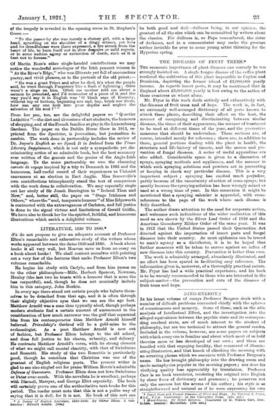THE DISEASES OF FRUIT TREES.* THE economic importance of plant
diseases can scarcely be too strongly insisted on. A single fungus disease of the coffee plant rendered the cultivation of this plant impossible in Ceylon and Dominica, depriving the former island of £2,000,000 yearly income. As regards insect pests, it may be mentioned that in England about £3,000,000 yearly is lost owing to the action of these creatures on wheat alone.
Mr. Fryer in this work deals entirely and exhaustively with the diseases of fruit trees and of hops. The work is, in fact, an extremely well-arranged dictionary of all pests known to attack these plants, describing their effect on the host, the manner of recognizing and discriminating between similar diseases, the times of their appearance, the manner of treatment to be used at different times of the year, and the preventive measures that should be undertaken. These sections are, of course, intended mostly for reference ; there are, in addition to these, general portions dealing with the plant in health, the structure and life-history of insects, and the causes -and pre- vention of fungal diseases. A series of useful appendices are also added. Considerable space is given -to a discussion of sprays, spraying methods and appliances, and the manner in which such spraying solutions and powders act in preventing or keeping in check any particular disease. This is a very important subject ; spraying has excited much prejudice, partly because of the uncertainty of action of some sprays, but mostly because the spraying solution has been wrongly mixed or used at a wrong time of year. In this connexion it might be mentioned that a spraying calendar is appended, with cross- references to the page of the work where each disease is fully described.
The author draws attention to the need for corporate action, and weloomes such indications of the wider realization of this need as are shown by the Silver Leaf Order of 1919 and the American Gooseberry Mildew Order of the same year. It was in 1912 that the United States passed their Quarantine Act directed against the importation of insect pests and fungal diseases into their country. As most epidemics can be traced to man's agency as a distributor, it is to be hoped that further measures will be taken to ensure against an influx of new diseases into this country. Prevention is better than cure.
The work is admirably arranged, abundantly illustrated, and no effort has been spared in facilitating easy reference. The information given is, moreover, of a thoroughly practical nature. Mr. Fryer has had a wide practical experience, and his book is to be warmly recommended to those who are interested in the subject-matter—the prevention and cure of the diseases of fruit trees and hops.










































 Previous page
Previous page